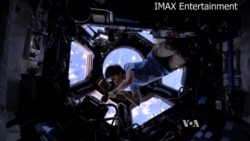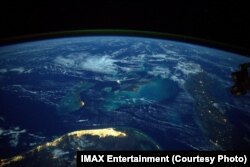Getting perspective on life: This is how filmmaker Toni Meyers described her feelings when looking at planet Earth from the International Space Station, 400 kilometers away.
There are no borders or nations when you can see the blue planet rotating in silent dark space. But when one looks at the Earth through the IMAX lenses used by the ISS crew, it is clear that humans are having a profound impact on the planet's surface.
Meeting the award-winning filmmaker at the Air and Space Museum in Washington, D.C., offered VOA the extra bonus of getting to know her in her familiar environment. We saw one of the first IMAX cameras, a big bulky, heavy machine that she used to shoot her 2010 documentary Hubble 3D IMAX, a film chronicling the effort of 7 astronauts aboard the Space Shuttle Atlantis to repair the Hubble Space Telescope.
Now, as then, Meyers trained the astronauts to film in their spacesuits in zero gravity. She says that A Beautiful Planet was easier to shoot because the new digital IMAX cameras are much lighter, smaller and they don’t run out of film so quickly.
Her goal was to show audiences Earth as if they were looking at it from the space station. She did not just do it for esthetic purposes. Meyers wanted to show people how they are affecting their home planet.
“You do see that there is a lot of pollution in the air, over particular industrialized nations, which comes of course from the amount of fossil fuels we are burning. You also see the extent to which fossil fuels are being exploited, certainly in Texas and the Gulf states," she said. "You see that the rainforest continues to be cut down and burned, although there are programs to contain that spread, but you also see areas that have been reclaimed, like the Chesapeake Bay which was a mess in the 1970s and it is now completely turned around to a healthy environment. And so we want to show people that when you get together and put their heads together to solve a problem, it can be solved.”
A celebrity in her own right, Meyers always collaborates with top actors to narrate her films. In Hubble 3D IMAX she picked Leonardo Di Caprio. Now, in A Beautiful Planet, Oscar-winning Jennifer Lawrence offers a compelling narration on the impact of deforestation on the environment, the melting of glaciers and the rise of sea levels which can threaten low-lying coastal cities such as New Orleans.
As one would expect, the footage is breathtaking. While during the daytime, we can see man’s presence through his impact on nature, at nighttime, our beautiful planet glows from the lights of civilization. The intensity of light often indicates the concentration of humanity in one area or the affluence of one country over another.
At nighttime, Earth’s atmosphere shimmers in iridescent colors. Beautiful and fragile at the same time, it reminds us not to take for granted what we have.
“One thing I wanted to do in the film,” says the filmmaker, “was draw the analogy between the space station as a closed system and the Earth as a closed system. Both of them have to have all the things we need to stay alive. Air, water, food, only on the space station you get resupply ships and the underlying message of the film is that Earth doesn’t get resupply ships. “
Meyers says, don’t dream of colonizing planets eons away. Clean house instead, take care of its natural beauty.
She says, “The thin line of the atmosphere that’s just above the earth, that's all there is between us and the cold black harsh vacuum of space. And even though we’ve discovered other planets around other stars, they are much too far away for present technology to take us there. It’s all we have!”








